Retail has been around for a mighty long time — and one thing we know is that there are many different approaches when it comes to retail design and setting up your store layout. However, there are also some common design strategies that all retailers can employ that lead to more sales for your business.
Designing your retail store's interior is a topic that we've been looking at recently in an effort to help boutique merchants be more successful and thrive in today's digital era. From telling your brand's story and creating immersive shopping experiences, to putting together head-turning window displays and signage essentials, when it comes to retail, the devil really is in the details. As such, we want you to help you get the basics down pat.
Grow your retail business with Shopify POS
Shopify POS is the most versatile system for unifying your in-store and online sales. Delight customers at every touchpoint and win back time to focus on what matters most to your business.
Not sure where to get started with your store layout and retail design? Here, we'll look at some of the basics when it comes to creating effective retail interiors that attract more customers to your store, get them browsing for more products, and encourage them to head toward the checkout.
It's vital to keep this fact in mind: From the moment someone steps into your store to the time they decide to check out (or leave your store without making a purchase), smart design decisions make a significant difference in regards to whether you make a sale or not.
Enter the Threshold
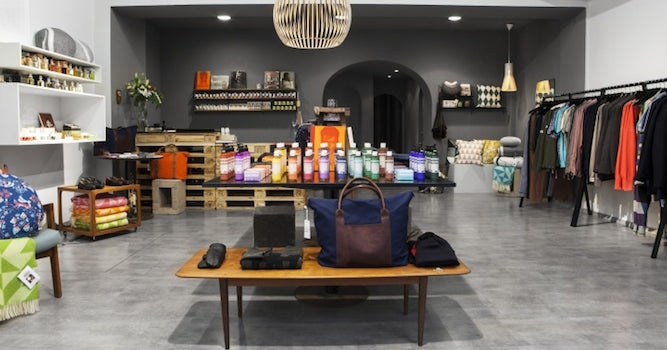 The threshold area, also known as the "decompression zone," is the very first space that prospective customers step into when they enter your store. It typically consists of the first five to fifteen feet worth of space, depending on the overall size of your store. It's also the space where your customers make the transition from the outside world and first experience what you have to offer.
The threshold area, also known as the "decompression zone," is the very first space that prospective customers step into when they enter your store. It typically consists of the first five to fifteen feet worth of space, depending on the overall size of your store. It's also the space where your customers make the transition from the outside world and first experience what you have to offer.
At this point, shoppers also make critical judgments like how cheap or expensive your store is likely to be and how well coordinated your lighting, fixtures, displays, and colors are. Since they're in a transition mode, customers are more likely to miss any product, signage, or carts you place there.
Then, Off To the Right
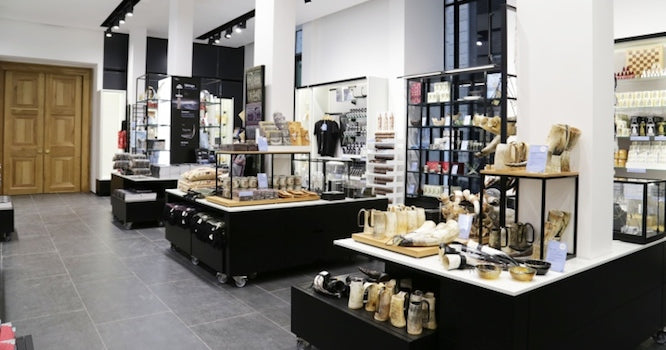 It's a well-known fact in the retail community that in North America, 90% of consumers turn right unconsciously upon entering a store. The first wall they see is often referred to as a "power wall," which acts as a high-impact first impression vehicle for your merchandise. So, be sure to give it extra special attention in terms of what you choose to display and how you display it.
It's a well-known fact in the retail community that in North America, 90% of consumers turn right unconsciously upon entering a store. The first wall they see is often referred to as a "power wall," which acts as a high-impact first impression vehicle for your merchandise. So, be sure to give it extra special attention in terms of what you choose to display and how you display it.
You'll want to make sure you capture your customer's attention with the products you put on display, whether it's your new or seasonal items, high-profit or high-demand products, or as a place to tell your product's stories.
For some great visuals and ideas for your power wall display, check out Pinterest.
Have Shoppers Walk a Path
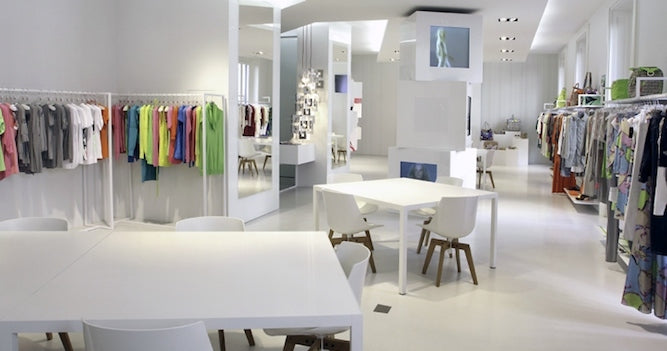 As a retailer, it's possible to use furniture, displays, racks, and other tools to create a clear path for your customers through your store. This will vary greatly depending on the size and your general store layout.
As a retailer, it's possible to use furniture, displays, racks, and other tools to create a clear path for your customers through your store. This will vary greatly depending on the size and your general store layout.
However, you know that most North American customers will naturally turn right — so, your next job is to make sure that as they do, they also continue walking throughout your store to gain the maximum exposure to your products. This not only increases the chances of them making a purchase, but a well-thought-out path can be a great way to strategically control the ebb and flow of foot traffic in your store.
Most stores use a circular path to the right (or counterclockwise) to get customers to walk through to the back of the store and come to the front again. Some will make it even easier by covering the path with a different texture or look from the general flooring, paying homage to the old saying "where the eyes go, the feet will follow."
Another tactic to keep in mind is that you want to use the path to lead your customers somewhere. So, for example, consider putting an eye-catching and attention-grabbing display at the end of your aisles.
But, Slow Them Down
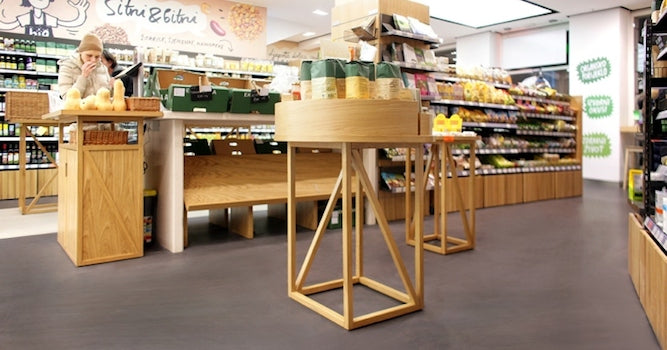 With all the time and effort you've put into properly merchandising and cross merchandising your products, the last thing you want is for incoming customers to hurry past them — this ultimately limits the number of products they'll purchase.
With all the time and effort you've put into properly merchandising and cross merchandising your products, the last thing you want is for incoming customers to hurry past them — this ultimately limits the number of products they'll purchase.
One way retailers combat this is through creating breaks that force them to pause. These are sometimes referred to as "speed bumps." Essentially, this can be anything that gives customers a visual break and can be achieved through signage or special/seasonal displays.
Most retailers effectively deploy the usage of what's referred to as "merchandise outposts," which are special display fixtures featuring products near the end of or in between aisles. These displays encourage impulse purchases while complementing products on display in close proximity.

Image: Pinterest
However, since you may not have "aisles" per say in your store, it's still important to think about grouping products in a way that makes sense from a shopper's perspective. Also, remember to keep "higher-demand" products displayed at eye-level while placing lower-grossing products at the bottom or above eye level. Lastly, It's recommended that you change up these speed bumps weekly or regularly enough to create a continued sense of novelty for repeat visitors.
To learn how to get more from your merchandising, check out these 6 visual merchandising ideas that can help you make more sales per square foot.
Make Sure Shoppers Are Comfortable
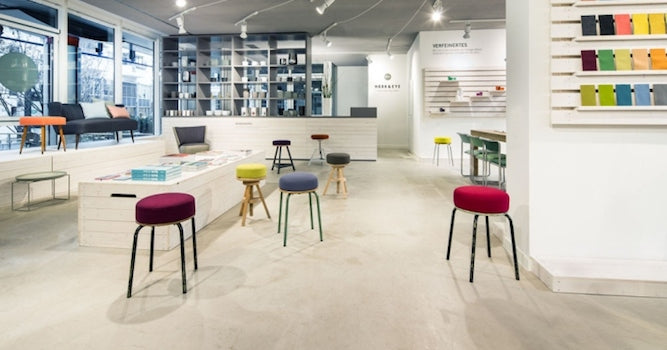 You may already be aware of something known as the "butt-brush effect," coined by consumer behavior expert Paco Underhill. He discovered that a typical customer, especially women, will avoid going after merchandise in an aisle where they could potentially brush another customer's backside or have their backside brushed. This holds true even if the customer is very interested in a given product. An easy way to avoid this problem is to ensure that your aisle, floor, and displays allow customers to have more than adequate personal space when browsing your products.
You may already be aware of something known as the "butt-brush effect," coined by consumer behavior expert Paco Underhill. He discovered that a typical customer, especially women, will avoid going after merchandise in an aisle where they could potentially brush another customer's backside or have their backside brushed. This holds true even if the customer is very interested in a given product. An easy way to avoid this problem is to ensure that your aisle, floor, and displays allow customers to have more than adequate personal space when browsing your products.
You can also make your store comfortable by incorporating a waiting area with comfy seats and benches to encourage customers to spend more time in your store. This is especially helpful for shoppers accompanied by someone who isn't interested in making a purchase. But keep the seats or benches facing the merchandise so that they're still top of mind for those lounging around in your store.
Lastly, Check Them Out (Not Literally)
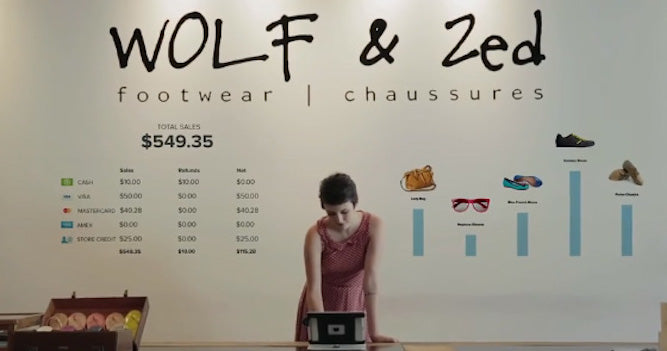
Where you place your checkout counter and your POS in a physical retail store is a question you can ask yourself for days. However, a good rule of thumb to remember is that the checkout should be located at a natural stopping point in the shopping experience that you've purposefully designed.
If customers naturally turn right when they enter, and you guide them to circle all the way around, you'll realize that the front left is probably the ideal location for your checkout counter. However, this decision also depends on the size and layout of the store itself, which means you'll have to use your best judgment on the most natural point to have that check-out counter.
Learn More: 50 Exceptional Shopify Stores
You'll also want to keep in mind that if you're a one-person show or don't have staff wandering the store, it'll be important to be able to see everything from a loss-prevention perspective. Other tips to keep in mind when designing your checkout counter are:
- Have a counter that's big enough for shoppers to place their bags and/or personal belongings
- Take advantage of the wall behind the counter to create interesting and engaging displays
- Encourage impulse purchases by stocking items customers crave or commonly need close by
- Be polite in person by asking questions like "Were you able to find everything you were looking for?" and in signage regarding your exchange or refund policies
Read more about optimizing point-of-purchase displays to boost sales.
Moving Forward With Your Store Layout and Retail Design
Designing your retail interior is a never-ending process where you can always be switching up, tweaking, adding, or taking away to create a resonating customer journey and experience. But at the end of the day, that's exactly what you want to focus on: the customer journey.
Have a walk-through yourself and see where the visual cues guide you or get your staff, friends, or family to do the same and give you honest feedback. Don't forget to observe your customers and see what they're drawn to, what they avoid, and how they move, then match that with your intended design. If you keep resilient and keep your eyes and ears open, you'll be sure to create a retail design that's a win-win for both you and your customers.
